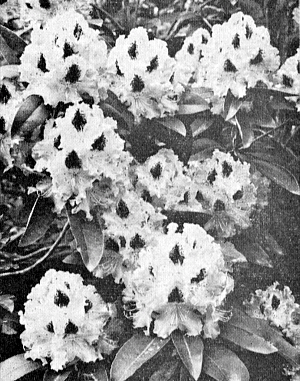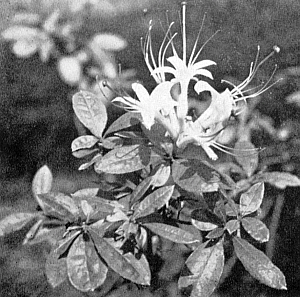QBARS - v28n1 Growing Rhododendrons in the Albany, New York Area
Growing Rhododendrons in the Albany New York Area
Hardiness Zone 5-B
Ralph H. Smith, Delmar, New York
Thirty and more years of experience have shown that rhododendrons can be grown in the Albany-New York area with success, provided some basic precautions are observed.
The problems are: subzero temperatures, frozen ground, bright sun and strong winds. Snow cover, an excellent insulator, cannot be counted on all the time. The sun's warmth on evergreen leaves starts them evaporating moisture, which the winds carry away. With frozen ground, the roots cannot replace the lost water. Leaves turn brown, dry out and die. If this is prolonged, the plant may die completely.
To prevent this, choose planting locations out of the winter sun, at least until afternoon and protected from the winter wind. The best location is in open shade; i.e., nothing overhead, but in the shadow of a building, a wooden fence, distant evergreens, or as a last resort, an open-topped burlap screen. Keep away from shallow rooted hedges or trees like the maples and beech, which will rob the rhododendrons of moisture and plant food. Plants may be set under deep-rooted oak trees, if branches are pruned high enough to walk under them and the slowly decomposing leaves keep the soil acid and well-mulched. Walnut and hickory tree roots give off toxins that result in slow death to rhododendrons.
If the soil is sandy, its moisture holding capacity must be built up by incorporating leaf mold from well-rotted oak leaves, peat moss or the well-rotted stump dirt from oaks, pines and hemlocks. If the soil is heavy clay, it is better to build beds on top of the clay, so the plants will have adequate drainage.
Protect the surface of the soil from deep freezing with a mulch of pine needles, oak leaves, or redwood or pine bark. This helps to conserve soil moisture, reduce weed growth and maintain soil acidity. Avoid fresh sawdust or wood chips, unless additional nitrogen compounds are incorporated with it. Untreated fresh sawdust will rob the plants of much needed nitrogen.
Against the occasional super-severe winter, which seems to come about once in every twenty years, the best and only protection is plants in good condition, plus the precautions taken above. Interestingly enough, it is the so-called mild winters that result in the most damage on Long Island. A series of warm days followed by sudden drops in temperature catches plants out of complete dormancy. Even the mild West Coast climate occasionally is replaced by cold blasts out of the mountains that kill plants to the ground.
One of the problems of hardiness involves early, sudden, hard freezes in the fall, before the evergreen plants are fully dormant. This frequently is the cause of loss of flower buds and sometimes of bark-splitting on the stems. Evergreen azaleas are particularly susceptible because they have not completed their growth in the fall.
What plants can be grown here with reasonable expectation that they will flower well except after that once-in-twenty-years hard winter? In general, we have to rely on the so called "Iron Clad" catawba hybrids, which evolved in western Europe over a hundred years ago. A few additional plants have shown they can take our climate, but the list is not a long one. The hardiness is derived from our native species, R. catawbiense , maximum , carolinianum and minus , while the improvement in color has come from Asiatic species.
As yet, there is no pure red-flowered rhododendron hardy in our area. The following are the best hybrids available. Varieties with an asterisk (*) are first choices:
|
|
|||||
|---|---|---|---|---|---|---|
| BEST REDS | PURPLE TINTS |
|---|---|
America |
Lee's Dark Purple& |
Nova Zembla* |
Purpureum Elegans |
PINKS |
The following Rhododendron species can be |
Mrs. C. S. Sargent |
grown with regard to some special problems: |
English Roseum |
maximum - White flowers in early July, native |
Roseum Pink |
to our region, but only in wooded swamps. |
WHITES |
Slow to bloom, flowers hidden by the new |
Boule de Neige* (slow growing) |
leaves and needs a moist site to do well. |
Catawbiense album* (tall growing) |
catawbiense - Rosy lavender, difficult to mix |
Album Elegans (tall, late) |
with other colors. Very hardy and a good |
Beaufort |
foliage plant. |
OTHER REDS |
catawbiense var. album * - White flowered selections |
Atrosanguineum |
from the wild, as Gable's "Catalgla." |
Charles Bagley |
dauricum - Rosy purple, deciduous, very early. |
Charles Dickens |
dauricum var. sempervirens - Half evergreen |
Caractacus |
in our area. |
H.W. Sargent |
carolinianum - Lilac pink, pink or white, small leaf early. |
Dr. H. C. Dresselhuys |
minus - Similar to carolinianum , taller, late. |
LAVENDER TINTS |
mucronulatum - Rosy purple, deciduous, very early. |
Roseum Elegans |
Several selections in clear pink, as "Cornell Pink." |
Everestianum* (frilled petals) |
smirnowii - Rose pink and white, leaves felted |
Parson's Gloriosum |
underneath, slow growing. |
| NEW HYBRIDS, reliably hardy | AZALEA HYBRIDS - Ghent (continued) |
|---|---|
fortunei 'Mrs. Butler' - Pale pink, |
Gloria Mundi - Orange-red |
fragrant, may lose flowers in a severe winter. |
Ignea Nova - Orange and pink |
Pallas - Orange-red |
|
Caroline - Pale lilac pink, fragrant |
Pucella - Pink |
Blue Peter - Lavender blue, purple blotch, |
Nancy Waterer - Bright yellow. Vigorous grower. |
may lose flowers in a severe winter. |
|
Beaufort - White. |
EXBURY & KNAP HILL HYBRIDS |
HALF-HARDY SPECIES |
Basilisk - Deep cream, yellow flare |
brachycarpum - Straw yellow to pale |
Berryrose - Salmon pink |
pink. Leaf hardy but often loses flower buds. |
Cecile - Pink |
caucasicum - Creamy white. Very slow. |
Gibraltar - Intense orange, flushed red |
Hard to find. |
Strawberry Ice - Peach pink |
degronianum - Pink and white. Leaves felted. |
Toucan - Creamy white. Fragrant. |
EVERGREEN AZALEAS - Half-hardy |
|
keiskei - Pale yellow. Small leaves. Dwarfish. |
or Not Fully Tested |
Hinodegiri - Red. Hardy if kept under the snow |
|
makinoi - Pink and white. Narrow leaves. |
Hino-crimson - Red. Hardy if kept under the snow |
sutchuenense - Large leaves, apparently |
mucronatum - White |
leaf-hardy. No flower buds as yet. |
mucronatum var. amethystinum - Lilac white. |
NEWER HYBRIDS - Small Leaved, |
Flowers below the snow line. |
Fairly Hardy |
Rosebud - Good pink. Double. |
Blue Diamond - Pale lavender blue |
Stewartstonian - Red. |
Chesapeake - Pink and white |
FAILURES |
Conemaugh - Lilac |
lapponicum - Alpine or tundra plant. |
Conewago - Lavender pink |
Hard to duplicate proper environment. |
Pioneer - Rose pink |
reticulatum - (Azalea dilatata) azalea |
P. J. M. hybrids - Rose purple |
with pink flowers |
Purple Gem - Bright violet |
racemosum - Barely survives. |
Ramapo - Bright violet |
discolor - Large leaves. Almost hardy. |
Windbeam - Pink and white |
Betty Wormald - Bright pink. Large flowers. |
AZALEAS - Species |
Mars - Nearly leaf hardy. |
albrechtii - Deep pink |
Excellent red flowers. |
arborescens - White, fragrant |
Naomi - Leaf hardy. Hasn't set flower buds. |
atlanticum - White to pink, Dwarf. |
David Gable - Winter killed. |
Pink Twins - Winter killed. |
|
bakeri - Orange red to scarlet |
Purple Splendour - Purple flowers, darker blotch. |
calendulaceum - Yellow to orange. |
NEW HYBRIDS, Not Yet Tried Sufficiently |
Flowers with the leaves. |
Dexter hybrids: |
canadense - Rose-purple. |
Brookville |
japonicum - Salmon pink to yellow white |
Wissahickon |
kaempferi - Brick red |
Scintillation - has flowered at Delmar, |
nudiflorum - Pale pink to almond white |
but flowers lost each year. |
roseum - Pale pink to rose pink. Fragrant. |
Wheatley |
schlippenbachii - Pink, white |
Westbury |
vaseyi - Pale pink to white |
Leach hybrids: |
viscosum - White. Fragrant. Native. |
Janet Blair |
AZALEA HYBRIDS - Ghent |
Shammarello hybrids: |
Coccinea Speciosa - Orange-red |
Holden |
Daviesi - Yellow white. Fragrant. |
Tony |
Almost all Kurume azaleas and the large-flowered double azaleas offered by the florists as forced plants at Christmas and Easter are all tender in our area.



